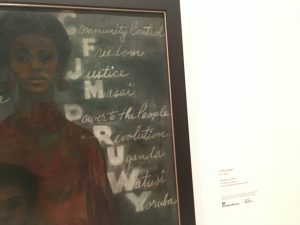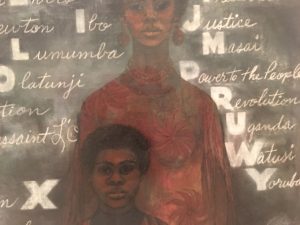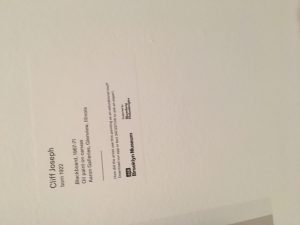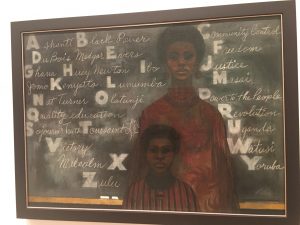In this assignment, I will be taking you on a journey through my own version of the “Soul of a Nation” exhibition. I will be discussing African American hardships/struggles and the people who helped black people gain the freedom they deserve.
African Americans have been struggling to get freedom since the times of slavery. They been oppressed by white people for centuries. Black people have endured so much from slavery, racial inequality, and incarceration of black people. Although the road for African Americans has been rough throughout history, they were able to preserve through the struggle with the help of various people.
The first painting we will be looking at is The First One Hundred Years by Archibald Motley.

In this painting, Motley creates a spine-crawling piece of artwork. There are many things going on in this painting. When I first saw this, one of the first things that caught my eye was the lynching of the person. Throughout history, lynching was a form of punishment that was given to only black people. It was a cruel moment in time that African Americans had to go through. If you look closely you can see two signs that says “whites only” on the left side and “colored only” on the right side. During the 60s, black people and white people weren’t allowed to be anywhere together. Whites had their own bathrooms, salons, stores, and even water fountains. Black people weren’t racially equal to white people. This painting shows the many trials and tribulations that black people had to go through as a race and Motley does a good job portraying what African Americans went through.
We now move on to the painting Unite by Barbara Jones-Hogu

In this painting you can see that there are a group of African Americans joining together for a cause. Looking at their hairstyles and the shape of their hands, you can see that they are apart of the Black Panther Party. The party was a movement that formed during the times of the Civil Rights. The group was created to help African Americans through police brutality. In the times of the Civil Rights movement, black people endured extreme brutality from police officers. They have been beaten and bruised by officers. In today’s society, there are many black people who were unarmed that have been struck down by police officers. African Americans have formed a new movement (Black Lives Matter) uniting together to fight and bring justice to those who has been slain by white police officers.
As we make our way through the exhibition, we come across another painting, Black Prince by Jarrell A. Wadsworth

This painting is a of a well-known person in history. Malcolm X is a known activist that helped black people get the justice they needed. This painting is different as Wadsworth uses letters and words to create it. As you look at the painting you can see that across the left side of his face it reads “Black Prince”. As you look down, there is a phrase across Malcolm’s shirt . It reads “I believe in anything necessary to correct unjust conditions political, economic, social, physical, anything necessary as long as it gets results”. Malcolm X was willing to do whatever it took to get justice. He didn’t care if it were violently or calmly; as long as it got the job done it didn’t matter. Malcolm X witnessed the injustice that black people were going through and was determined to make sure that justice was serve.
The next painting that we will be seeing is April 4 by Sam Gilliam

This painting created by Sam Gilliam is based on the assassination of Martin Luther King Jr. He is known for helping African Americans be racially equally. He is best known for being one of the pioneers for the Civil Rights movement. He’s famous for holding many protests. Compared to Malcolm X, Martin Luther King Jr, wanted to have nonviolence protests. He wanted to peace in getting the justice that black people deserved. In doing what he could to help, he too was treated poorly by white people. On April 4, 1968, Martin Luther King Jr was assassinated. His life was taken away because he wanted to fight for the equality for African Americans. In the painting there are colors of red to represent the blood of King Jr.
As we come to a close on this exhibition, we see our final artwork.
Curtain for William and Peter by Melvin Edwards

This metal sculpture is made from barbed wire and chains. For every two wire there is a chain attach to them. This sculpture was created to for both slavery and incarceration. During the times of slavery, African Americans were constantly in chains. They had no freedom and they weren’t considered human beings. They were treated poorly and worse than animals. They were beaten and bruised everyday from their owners. Some slaves did running away to get the freedom they needed. When we see barbed wires, we often think of jail. There are many African Americans who are incarcerated. They are the race that has the most inmates in jail. There are black men who are also wrongfully convicted. Black people has endured so much wrong and so much hate from white people.
Through this mini exhibition of the “Soul of a Nation”, we learned that African Americans have gone through many hardships throughout the years. They were beaten and bruised fighting for the freedom and justice they deserved. During the times of slavery, the civil rights movement, and even incarceration, black people continued to unite and stand together. Activists such as Martin Luther King Jr and Malcolm X did everything they could to help African Americans become integrated with white people. Despite all that black people have gone through as a race, they were able to unite and preserve through the struggles together.



















